Book contents
- Frontmatter
- Contents
- Series preface
- List of contributors
- Editor's preface
- Acknowledgments
- Part I Models of juror decision making
- 1 Introduction
- 2 Some steps between attitudes and verdicts
- 3 The influence of outcome information and attitudes on juror decision making in search and seizure cases
- 4 Algebraic models of juror decision processes
- 5 Stochastic models of juror decision making
- 6 Formal and empirical research on cascaded inference in jurisprudence
- 7 Argument structuring and evidence evaluation
- 8 The story model for juror decision making
- Part II Commentaries
- Index of names
- Index of subjects
2 - Some steps between attitudes and verdicts
Published online by Cambridge University Press: 04 August 2010
- Frontmatter
- Contents
- Series preface
- List of contributors
- Editor's preface
- Acknowledgments
- Part I Models of juror decision making
- 1 Introduction
- 2 Some steps between attitudes and verdicts
- 3 The influence of outcome information and attitudes on juror decision making in search and seizure cases
- 4 Algebraic models of juror decision processes
- 5 Stochastic models of juror decision making
- 6 Formal and empirical research on cascaded inference in jurisprudence
- 7 Argument structuring and evidence evaluation
- 8 The story model for juror decision making
- Part II Commentaries
- Index of names
- Index of subjects
Summary
The paradox of individual differences
Most research that has attempted to predict verdict preferences on the basis of stable juror characteristics, such as attitudes and personality traits, has found that individual differences among jurors are not very useful predictors, accounting for only a small proportion of the variance in verdict choices. Some commentators have therefore concluded that verdicts are overwhelmingly accounted for by “the weight of the evidence,” and that differences among jurors have negligible effects. But there is a paradox here: In most cases the weight of the evidence is insufficient to produce firstballot unanimity in the jury (Hans & Vidmar, 1986; Hastie, Penrod, & Pennington, 1983; Kalven & Zeisel, 1966). Different jurors draw different conclusions about the right verdict on the basis of exactly the same evidence. That these differences are consequential is indicated by the frequently replicated finding that first ballot splits are the best-known predictor of the final jury verdict. In most laboratory studies of jury decisions, there are some juries, as well as jurors, that reach nonmodal verdicts. The inescapable conclusion is that individual differences among jurors make a difference.
Of course these influential individual differences need not be differences in character or philosophy of life. The process by which a juror comes to a decision about the right verdict may resemble Brownian motion more than it does the Galilean laws of cause and effect. First, many trials are long and any given juror's level of attention is likely to vary considerably.
- Type
- Chapter
- Information
- Inside the JurorThe Psychology of Juror Decision Making, pp. 42 - 64Publisher: Cambridge University PressPrint publication year: 1993
- 26
- Cited by



